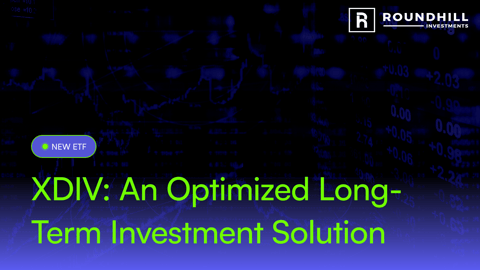XPAY vs. XDIV: Choosing the Right Tax-Efficient S&P 500 ETF for Your Goals
Introduction
Investors looking for exposure to the S&P 500 often assume they have to choose between simplicity, tax-efficiency, and income. But Roundhill’s two new ETFs, XPAY and XDIV, offer two very different approaches to achieving tax-efficient outcomes depending on whether you’re prioritizing income today or growth tomorrow.
At first glance, both XPAY and XDIV track the S&P 500 and aim to be tax-efficient. But that’s where the similarities end. These ETFs are designed with two distinct investor profiles in mind and understanding how they differ can help you find the right strategy.
Income Now: XPAY
XPAY, the Roundhill S&P 500 Target 20 Managed Distribution ETF, is designed for investors who want consistent, monthly income without triggering immediate taxes. How? It aims to deliver a 20% target annualized distribution that is largely structured as return of capital (ROC). This means that, unlike ordinary dividends, the cash payments aren't taxed when received. Instead, they reduce the investor’s cost basis, deferring the tax liability until the shares are sold.
This structure makes XPAY appealing for income-focused investors who are in a high tax bracket or simply want cash flow without the typical annual tax burden. Whether used to support retirement income or other cash needs, XPAY offers a simple, hands-off way to get money out of an S&P 500 strategy without selling shares. However, because the distributions are ROC, they do reduce the cost basis of the investment over time—potentially increasing the capital gains when the investor eventually exits.
Growth Tomorrow: XDIV
On the other side is XDIV, the Roundhill S&P 500 No Dividend Target ETF, which is designed for tax-conscious long-term investors. XDIV targets S&P 500 exposure without passing through dividends. The goal is simple: aim to deliver the total return of the S&P 500 without distributing income that triggers annual taxes.
For investors with long time horizons and taxable accounts, think high earners in accumulation mode, XDIV offers a highly efficient way to stay invested without the friction of dividend reinvestment or annual tax drag. With a net expense ratio of just 0.0849%, it’s also a cost-effective solution for those who want to optimize after-tax compounding over decades.1
Which to Choose?
The difference comes down to cash flow versus compounding.
- XPAY is for investors who need cash now but want to defer taxes until later. It’s ideal for those living off their portfolios, who don’t want to sell shares but still want to minimize annual tax liabilities.
- XDIV is for investors who want to grow their wealth tax-efficiently and are willing to delay gratification. It’s optimized for those who prefer to reinvest in-place without receiving taxable income, making it perfect for taxable accounts in the growth phase.
Both funds are clever takes on how to deliver S&P 500 exposure more thoughtfully in today’s tax-aware environment. The best choice ultimately depends on what the investor wants their capital to do: pay them today or grow quietly for tomorrow.
Footnotes
1 The net expense ratio is 0.0849%, and the gross expense ratio is 0.215%. Reflects fees incurred by the Fund before waivers and reimbursements, including but not limited to management fees, 12b-1 fees, and acquired fund fees and expenses. Pursuant to a contractual agreement, Roundhill has agreed to waive its management fee and reimburse certain expenses to prevent the Fund’s Annual Fund Operating Expenses from exceeding 0.0849% until June 10, 2026.
Disclosures
There is no guarantee that the Fund will be able to successfully avoid paying dividends and distributions. Additionally, there can be no guarantee that the Fund will be successful in its strategy to provide shareholders with a total return that matches that of the S&P 500® Index.
Investors should consider the investment objectives, risk, charges and expenses carefully before investing. For a prospectus or summary prospectus with this and other information please call 1-855-561-5728 or visit the website at https:// www.roundhillinvestments.com/etfs/. Read the prospectus or summary prospectus carefully before investing.
Click here for the XDIV prospectus.
Click here for the XPAY prospectus.
Roundhill Financial Inc. serves as the investment advisor. The Funds are distributed by Foreside Fund Services, LLC which is not affiliated with Roundhill Financial Inc., U.S. Bank, or any of their affiliates.
XDIV Disclosures:
S&P 500 ETFS RISKS. The Fund will have significant exposure to the S&P 500® Index through its investments in the S&P 500 ETFs. Accordingly, the Fund will subject to the risks of the S&P 500 ETFs, set forth below. In addition to these risks, each S&P 500 ETF is also subject to the following risks to which the Fund is also subject, which are described within the section entitled “Principal Risks”: Active Market Risk, Asset Class Risk, Concentration Risk, Cybersecurity Risk, Operational Risk and Structural ETF Risk.
Active Management Risk. The Fund is actively-managed and its performance reflects investment decisions that the Adviser and/or Sub-Adviser makes for the Fund. Such judgments about the Fund’s investments may prove to be incorrect.
Active Market Risk. Although Fund Shares are listed for trading on the Exchange, there can be no assurance that an active trading market for Fund Shares will develop or be maintained.
New Fund Risk. The Fund is a recently organized investment company with a limited operating history. As a result, prospective investors have a limited track record or history on which to base their investment decision.
Investment Strategy Risk. There is no guarantee that the Fund will be able to successfully avoid paying dividends and distributions. Additionally, there can be no guarantee that the Fund will be successful in its strategy to provide shareholders with a total return that matches that of the S&P 500® Index. In order to effectuate the Fund’s strategy, the Adviser is relying upon the ability to conduct in-kind redemptions of the Fund’s S&P 500 ETF holdings. In the event that the Adviser is unable to do so due to factors such as broker-dealer balance sheet availability constraints, market volatility, regulatory changes, contrary IRS positions relating to an ETF’s use of in-kind creations or redemptions, or operational issues, the ability of the Adviser to avoid the taxable income generated by an investment in Fund Shares may be impaired and may force the Fund to make a dividend or distribution payment.
XPAY Disclosures:
Return of capital represents a return of a portion of a Fund shareholder’s invested capital and is not taxable in the year it is received unless the distribution exceeds a shareholder’s basis in the Fund. However, a return of capital may result in an increase in a later gain on a sale of Fund Shares or a reduction of a loss.
The strategy targets those investors who seek monthly income from their investment but wish to retain exposure to the return of the S&P 500® Index. Because a significant portion of the Fund’s distributions will consist of return of capital, the Fund may not be an appropriate investment for investors who do not want their principal investment in the Fund to decrease over time or who do not wish to receive return of capital in a given period.
Market Risk. Market risk is the risk that a particular security, or shares of the Fund ("Fund Shares") in general, may fall in value. Securities are subject to market fluctuations caused by such factors as economic, political, regulatory or market developments, changes in interest rates and perceived trends in securities prices.
Distribution Tax Risk. The Fund currently expects to make distributions on a monthly basis. These distributions are expected and designed to exceed the Fund’s income and gains for the Fund’s taxable year. Distributions in excess of the Fund’s current and accumulated earnings and profits will be treated as a return of capital. The Fund seeks to be managed such that the entirety of the Fund’s distributions will be treated as a return of capital. A return of capital distribution generally will not be taxable but currently will reduce the shareholder's cost basis and will result in a higher capital gain or lower capital loss when those Fund Shares on which the distribution was received are sold. Once a Fund shareholder’s cost basis is reduced to zero, further distributions will be treated as capital gain if the Fund shareholder holds Fund Shares as capital assets. Additionally, any capital returned through distributions will be distributed after payment of Fund fees and expenses. Because a significant portion of the Fund’s distributions will consist of return of capital, the Fund may not be an appropriate investment for investors who do not want their principal investment in the Fund to decrease over time or who do not wish to receive return of capital in a given period.
Managed Payout Risk. The Fund intends to pay monthly distributions to shareholders based upon based on the NAV of the Fund on the final business day of December each calendar year. Distributions will be paid from Fund assets regardless of the Fund’s performance or the level of dividends, income and capital gains earned by the Fund, and will reduce the amount of assets available for investment by the Fund. If distributions paid by the Fund exceed the Fund’s earnings and profits, distributions of that excess will be treated as a return of capital to the extent of your tax basis in your Fund Shares.
The targeted annual distribution rate to be paid by the Fund each year is based on the NAV of the Fund on the final business day of December of the prior year. The targeted annual distribution rate is not guaranteed and may be decreased or increased in the future. The actual annual distribution rate paid by the Fund each month or year may be higher or lower than the targeted rate.
SPY ETF Risks. The Fund will have significant exposure to the S&P 500 Index and the SPY ETF through its investments in the SPY FLEX Options. Accordingly, the Fund will subject to the risks of the SPY ETF.
FLEX Options Risk. Trading FLEX Options involves risks different from, or possibly greater than, the risks associated with investing directly in securities. The Fund may experience losses from specific FLEX Option positions and certain FLEX Option positions may expire worthless. The FLEX Options are listed on an exchange; however, no one can guarantee that a liquid secondary trading market will exist for the FLEX Options. In the event that trading in the FLEX Options is limited or absent, the value of the Fund’s FLEX Options may decrease.
Active Management Risk. The Fund is actively-managed and its performance reflects investment decisions that the Adviser and/or Sub-Adviser makes for the Fund. Such judgments about the Fund’s investments may prove to be incorrect.
Active Market Risk. Although Fund Shares are listed for trading on the Exchange, there can be no assurance that an active trading market for Fund Shares will develop or be maintained.
Concentration Risk. The Fund may be susceptible to an increased risk of loss, including losses due to adverse events that affect the Fund’s investments more than the market as a whole, to the extent that the Fund’s investments are concentrated in the securities and/or other assets of a particular issuer or issuers, country, group of countries, region, market, industry, group of industries, sector, market segment or asset class.
Derivatives Risk. The use of derivative instruments (i.e. options contracts) involves risks different from, or possibly greater than, the risks associated with investing directly in securities and other traditional investments. These risks include: (i) the risk that the counterparty to a derivative transaction may not fulfill its contractual obligations; (ii) risk of mispricing or improper valuation; and (iii) the risk that changes in the value of the derivative may not correlate perfectly with the underlying asset.



